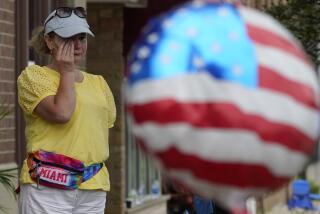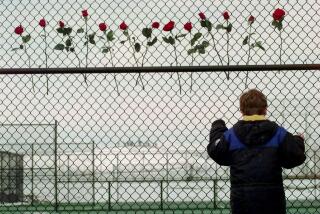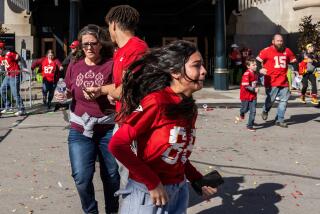The worst mass shooting? A look back at massacres in U.S. history
- Share via
Note, Oct. 1, 2017: This article was published June 14, 2016. At least 58 people were killed in an attack Sunday, Oct. 1, 2017, on the Las Vegas Strip, making that incident the deadliest shooting since at least 2012.
After news broke Sunday of the gunman who stormed an Orlando, Fla., nightclub, killing 49 people and wounding 53 others, news organizations began comparing the attack with other high-profile mass shootings.
The Los Angeles Times, like many outlets, called it “the deadliest in American history.”
Critics pushed back, saying the phrase was inaccurate and disrespectful to darker chapters of American history. Death tolls, they pointed out, were much higher in other shootings more than a century ago, including race riots and labor disputes in the early 1900s and massacres perpetrated by the U.S. Army or settlers in the American West.
The dispute largely boils down to definitions.
“The term ‘mass shooting’ is imprecise,” said Grant Duwe, director of research at the Minnesota Department of Corrections and the author of a book about mass murders in the U.S. Instead, he said, the events that Americans today recognize as mass shootings, including the death of 28 people in Newtown, Conn., and the San Bernardino terrorist attack, are “mass public shootings.”
Mass public shootings take place in public or semipublic places such as schools or entertainment venues, Duwe said, and are not a byproduct of another type of crime, such as a robbery, a gang turf war or an act of domestic violence. Murder is the goal.
The killings, carried out by a lone shooter or a small number of attackers, unfold in hours or less, separating them from serial killer shootings that occur over weeks, months or years. The definition does not typically include killings that are part of military operations.
By that definition, the Pulse nightclub shooting is the deadliest mass public shooting in U.S. history.
But critics counter that the more narrow terminology prevents comparisons with some of the nation’s bloodiest chapters.
”It’s important to put the Pulse shooting in historical context not to minimize the terror wreaked by a disturbed and bigoted individual’s easy access to military-grade weapons, but to recognize that gun culture in the U.S. has gone hand in hand with violent hatred for a long time,” USC law professor Ariela Gross wrote Tuesday in a Wall Street Journal op-ed.
In the 19th century and the first part of the 20th century, people in positions of power, such as cavalry members and religious groups, often murdered the so-called have-nots, Duwe said. “In a lot of those cases, we seldom see anyone who was ever charged,” he said.
A broader definition of “mass shooting” includes many of those incidents. Among them:
- Sand Creek Massacre: In 1864, about 675 soldiers rode toward a tribal campsite in eastern Colorado and opened fire, killing more than 165 Cheyenne and Arapaho tribe members. More than half the dead were women and children, according to the National Park Service. Black Kettle, a Cheyenne chief, is said to have waved a white flag as the troops approached. He survived the massacre and was killed four years later by Gen. George Armstrong Custer.
- Clear Lake Massacre: In 1850, a U.S. cavalry unit descended on a tribe of Pomo Indians living on an island in Lake County, Calif., and killed at least 60 men, women and children. The army had sought revenge for the death of two white settlers who had “long enslaved, brutalized and starved indigenous people in the area,” according to a plaque placed at the site by the California Department of Parks and Recreation.
- Wounded Knee Massacre: In 1890, U.S. Army troops near Wounded Knee Creek in South Dakota opened fire on Lakota Chief Big Foot and a band of his tribe. More than 150 men, women and children were killed.
Other mass shootings involved altercations between pioneer settlers and communities already established in the West, including the Mountain Meadows Massacre in 1857. A wagon train headed to California was attacked by Mormons as it passed through southwest Utah. About 120 people were killed.
Some notable racial and class-based clashes in the late 19th and early 20th century could also be considered mass shootings:
- Rock Springs massacre: In 1885, a group of white men and women fatally beat and shot at least 28 Chinese immigrant laborers during a riot at a coal mine in southwestern Wyoming. Historians say the riot was sparked by growing displeasure over the mine’s practice of hiring Chinese workers and paying them a lower wage than American citizens.
- Tulsa race riots: A white mob attacked black residents in Tulsa, Okla., in 1921 and burned down the Greenwood neighborhood, which was then the wealthiest black business district in the United States. Modern estimates place the death toll at 50 to 300 people, many of them shot.
- Elaine massacre: Black men in Elaine, a small town in eastern Arkansas, met in the fall of 1919 to discuss how to collect more money for their cotton crops. During the meeting, a white man who was deputized was shot. In the riot that followed, as many as 200 black people were shot and killed.
ALSO
At an Orlando hospital, the victims kept coming — but so did an army of nurses
Survivor on Orlando gunman: ‘He was not going to stop killing people until he was killed’
More to Read
Sign up for Essential California
The most important California stories and recommendations in your inbox every morning.
You may occasionally receive promotional content from the Los Angeles Times.











